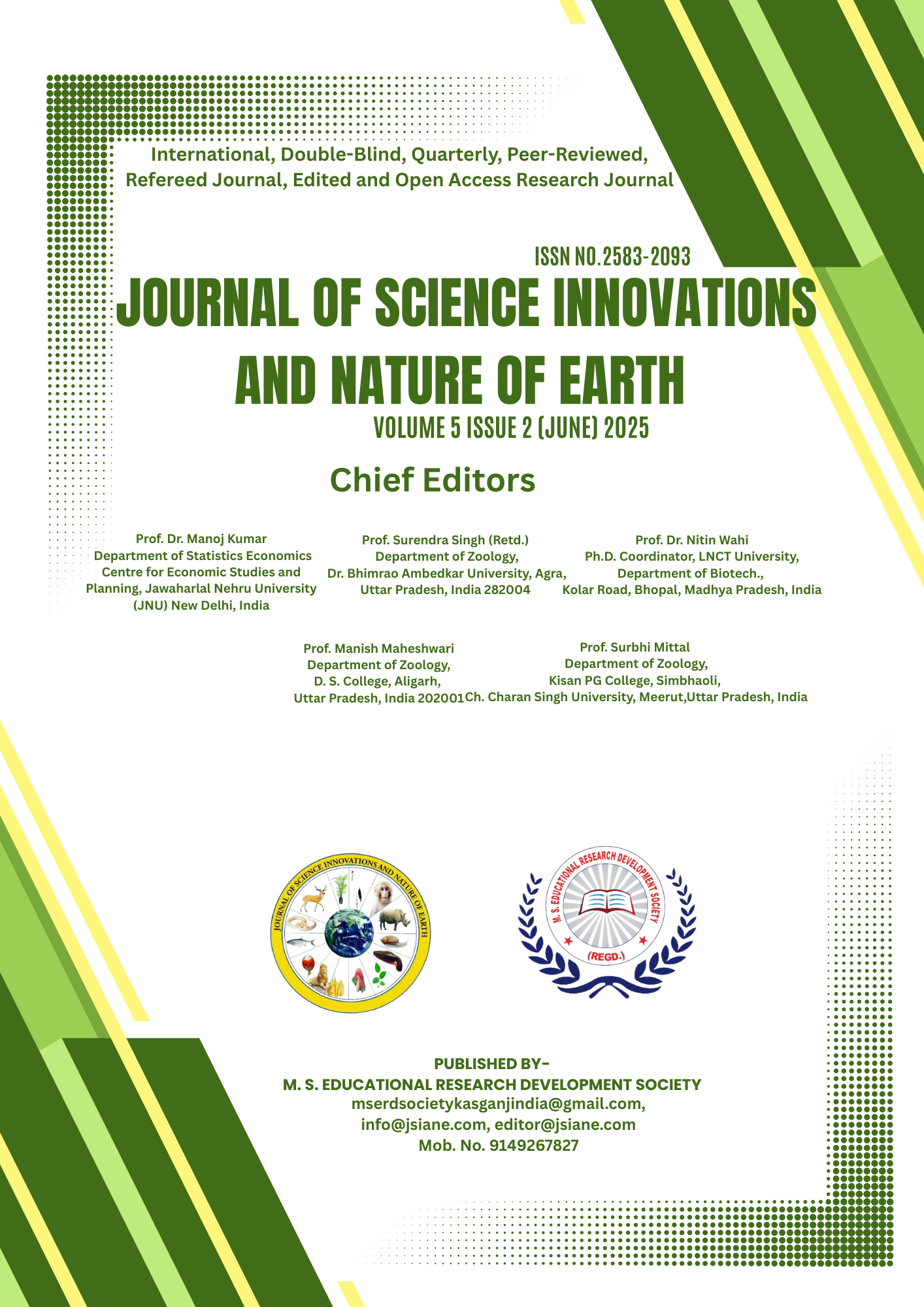Understanding Mosquito Biodiversity in India: Key Genera, Ecology, and Disease Transmission – A Review
DOI:
https://doi.org/10.59436/jsiane.401.2583-2093Keywords:
Mosquito diversity, Vector ecology, Aedes, Culex, Anopheles, IndiaAbstract
Mosquitoes are among the most medically important insects in India, serving as vectors for a wide range of diseases, including malaria, dengue, chikungunya, filariasis, and Japanese encephalitis. The Indian subcontinent, with its diverse ecosystems ranging from Himalayan foothills to coastal plains supports a rich diversity of mosquito fauna. This review provides a comprehensive account of mosquito diversity across India, focusing on the major genera: Anopheles, Aedes, Culex, Mansonia, and Armigeres. Each genus exhibits unique ecological adaptations, breeding habitats, biting behavior, and vectorial capacities. Anopheles species are predominantly rural and forest-dwelling, while Aedes thrive in urban settings and artificial containers. Culex and Mansonia are common in polluted or semi-aquatic environments, and Armigeres are emerging as secondary vectors in some regions. The review also highlights the ecological factors influencing mosquito distribution, including climate change, deforestation, urbanization, and water management practices. Special attention is given to recent shifts in species ranges and the emergence of new vector hotspots. Despite extensive research, several regions and species remain under-studied, particularly in the northeastern and central parts of India. There is a pressing need for integrative taxonomic approaches, molecular surveillance, and ecological modeling to fully understand mosquito biodiversity and vector potential. By synthesizing current knowledge, this article aims to aid entomologists, public health officials, and policy makers in designing effective, location-specific vector surveillance and control programs. Understanding mosquito diversity is not only essential for disease prevention but also for maintaining ecological balance in India's varied landscapes.
References
Barik, T. K., Sahu, B., & Swain, V. (2009). A review on malaria vector control with particular reference to India. International Journal of Environmental Research and Public Health, 6(1), 11–22.
Barik, T. K., Sahu, B., & Swain, V. (2011). A review on malaria vector control with particular reference to India. International Journal of Environmental Research and Public Health, 6(1), 4–11.
Bockarie, M. J., Pedersen, E. M., White, G. B., & Michael, E. (2009). Role of Culex quinquefasciatus in the transmission of lymphatic filariasis. Trends in Parasitology, 25(12), 581–588.
Das, M. K., Raghavendra, K., Sharma, S. K., & Dash, A. P. (2012). Distribution and seasonal variation of malaria vectors in India. Journal of Vector Borne Diseases, 49(3), 151–160.
Dash, A. P., Adak, T., Raghavendra, K., & Singh, O. P. (2007). The biology and control of malaria vectors in India. Current Science, 92(11), 1571–1578.
Dash, A. P., Bhatia, R., Sunyoto, T., & Mourya, D. T. (2012). Emerging and re-emerging arboviral diseases in Southeast Asia. Journal of Vector Borne Diseases, 49(2), 77.
Ghosh, A., Dar, L., & Ghosh, S. (2012). Epidemiological and entomological scenario of dengue in India: A review. International Journal of Mosquito Research, 1(1), 5–9.
Kumar, A., Rao, C. R., & Pandit, V. (2011). Dengue in India: An overview. International Journal of Research in Medical Sciences, 4(3), 785–790.
NVBDCP. (2021). Annual Report 2020–21. National Centre for Vector Borne Diseases Control, Ministry of Health and Family Welfare, Government of India.
Raghavendra, K., Barik, T. K., Reddy, B. P. N., Sharma, P., & Dash, A. P. (2011). Malaria vector control: From past to future. Parasitology Research, 108(4), 757–779.
Rajavel, A. R., & Natarajan, R. (2006). Mosquitoes of the mangrove forests of India. Journal of the American Mosquito Control Association, 22(4), 637–640.
Reuben, R., Tewari, S. C., & Hiriyan, J. (1994). Mosquito biodiversity in India. In: Mosquito Taxonomy Workshop Report, Centre for Research in Medical Entomology, Madurai.
Reuben, R., Tewari, S. C., Hiriyan, J., & Akiyama, J. (1994). Illustrated keys to species of Culex (Culex) associated with Japanese encephalitis in Southeast Asia (Diptera: Culicidae). Mosquito Systematics, 26(2), 75–96.
Service, M. W. (2012). Medical Entomology for Students (5th ed.). Cambridge University Press.
Sharma, S. K., Upadhyay, A. K., & Haque, M. A. (2006). Malaria vector management: Current scenario and future prospects. Journal of Vector Borne Diseases, 43(3), 123–132.
Sharma, S. K., Upadhyay, A. K., Haque, M. A., & Tyagi, P. K. (2014). Malaria and vector control in India: Challenges and future prospects. The Indian Journal of Medical Research, 139(2), 167–178.
Singh, O. P., Dykes, C. L., & Das, M. K. (2020). DNA barcoding and molecular identification of Indian mosquitoes. Acta Tropica, 208, 105428.
Subbarao, S. K. (1998). Anopheline species complexes in South-East Asia. New Delhi: World Health Organization, South-East Asia Regional Office.
Tyagi, B. K., Munirathinam, A., & Venkatesh, A. (2015). A catalogue of Indian mosquitoes. ICMR-Centre for Research in Medical Entomology.
WHO India. (2021). Vector-Borne Diseases in India: Surveillance and Elimination. World Health Organization Country Office for India.
WHO. (2012). Global Plan for Insecticide Resistance Management in Malaria Vectors (GPIRM). World Health Organization.

Downloads
Published
Issue
Section
License
Copyright (c) 2025 Maharaj Singh Educational Research Development Society

This work is licensed under a Creative Commons Attribution-NonCommercial 4.0 International License.









